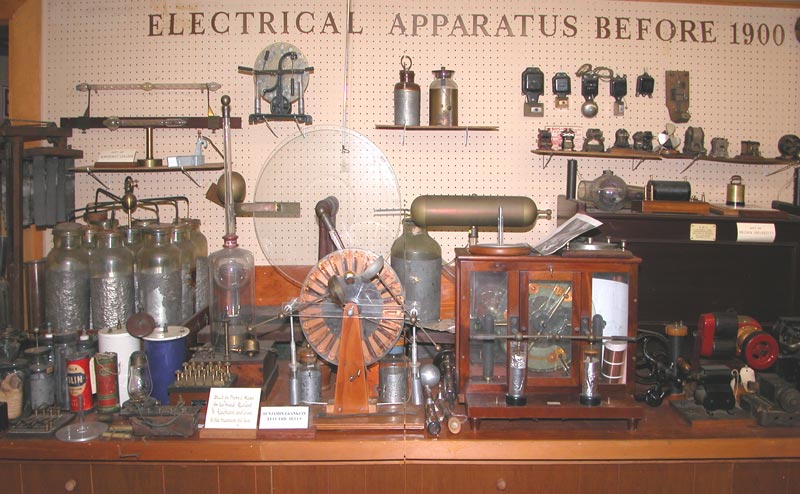Probably one of the curious objects here is the so-called “plunge battery”. These are carbon and zinc electrodes, and to turn it on, you put the electrodes in the electrolyte, and to turn it off, you pull them out.
What is next to it is a bank of Leyden jars…it’s named for the town in Holland where they were first used…and they are a form of capacitor with the tin foil on the outside of the bottle, and the tin foil on the inside of the bottle…the two electrodes of an electrostatic capacitor. And they put in a bank of them…there are…
Fred – “And they just used the glass as the dielectric between the two plates…”
Exactly. There are nine of them here and they’re all in parallel to get a larger capacitance. I don’t know how many microfarads this is, but it’s probably pretty high.
Down here is a collection of various types of batteries and Leyden jars…there’s a little Leyden jar right here, for example…but here’s a wet battery…here’s another wet battery…these are more wet batteries…actually, there was a certain battery called the “Edison-Leland Battery”, and that porcelain one right there is an Edison-Leland Battery. Those were the kind of batteries used in the Massie Wireless Station next door, originally. You wouldn’t run to the hardware store and buy a number-six battery, you know. You know the number-six battery, like this. I played with those when I was a kid. I could run down to Pawtuxet Paint and Hardware, you know, and buy these things pretty cheap in the depression.
There are ancient instruments here. That’s a little Wimshurst Generator up there…electrostatic…up on the shelf.
Wimshurst Generator
This is a glass disk electrostatic generator. There should be leather pads on those springs…you rub the glass and I guess you rub the electrons off it and it charges things up.
Fred – “This looks like it was in a physics class…a demonstration in a physics class.”
Well, as a matter of fact, quite a bit of this stuff came from Brown University. They were just junking it…and they gave it to us. This Wimshurst generator was made by Thorn Mayes, for whom the Mayes building is named. Two wheels turn in opposite directions. One is positive and one is negative, and this little bell will go back and forth between the two.
Franklin’s Bells
Fred – “That was a Benjamin Franklin idea, wasn’t it?”
Yes. Benjamin Franklin was so intrigued by this…this is in his apartment in London…he installed such a system. This one went to a rod that was sticking out the roof with a sharp point on the end of it, and this one went to a chain hanging in a well in the back yard. World’s first antenna, world’s first ground…Benjamin Franklin…approximately 1752, although this is later, this is 1770, or so, in London. It was sort of a weather predictor for him, because when a storm develops, the electricity in the atmosphere charges, and he would see these things start to move…you know…the variation on a barometer, if you will.
Fred – “Now, you’ve got one in the Massie Building, right?
Yes, Colin built that.
Fred – “Does it work?”
Yes, as a matter of fact, the day that Colin made it…it was a Thursday…and I had an amateur radio net on Thursday evenings…and I went out that evening, and I was sitting at the ham station with my back to the…Franklin’s Bells. And I was talking to somebody on the…it could have been Colin I was talking to…on the radio. Anyway, it was a stormy night, and all of a sudden…”ding…ding…ding…ding”…right behind my head. So I can testify that it works! And thanks to Colin who built it.
Fred – “Didn’t you also tell me Franklin had one in his house…that he got his wife to charge up batteries?”
Oh…yes, she wasn’t altogether tickled about the idea.
Fred – “I can imagine!”
Here is just a collection of little motors and generators and things of that kind, but this is quite fascinating…you know, potentiometers are designed with a different curve of variation and resistance as you rotate the knob. Some are linear, some are logarithmic…some are various things. This one, I think, is logarithmic. You see the carbon on here, and the contact plate…it starts off high resistance…as you go around you’re hitting more carbon, so you get a lower and lower resistance. Over here it’s a short circuit. So that’s a pretty early version of a potentiometer with a variable resistance.
Unfortunately, this…this is another Wimshurst generator…but things don’t travel very well…and this one got broken in transit sometime. It’s a Wimshurst…only one is turning…I’ve never made that work.
This is mostly the way Franklin made his electricity…you rub the glass wand…and it builds up a charge.
X-Rays
Here is an X-Ray tube. Very high voltage between them, and the X-Ray beam fires out this way, off the 45-degree angle.
Fred – “X-Rays are shorter wavelengths?”
Yes, X-Rays are beyond the visible light.
Fred – “They were pretty dangerous originally, when people didn’t really know what they were getting themselves into.”
Well, isn’t it the way with every discovery we make? Look at the chemicals we make…they’re awful things…some of them…and, unfortunately, it make a lot of unknowing people excessively cautious about things they don’t really understand.
Little magnetos, little motors…there’s a strain insulator for a high-power radio transmitter.
Fred – “And this big variable coil here…”
Yes, this came from Brown University, also.
Oh, this is the world’s first snap-acting switch.
Little motors like that, were the great toys. This particular type was common with Erector Sets.
Text from the transcript of a tour of New England Wireless & Steam Museum’s Wireless Building given by Robert W. Merriam on a winter day in 2012. Transcription by Craig H. Moody, K1CHM. Edited by Fred Jaggi.
